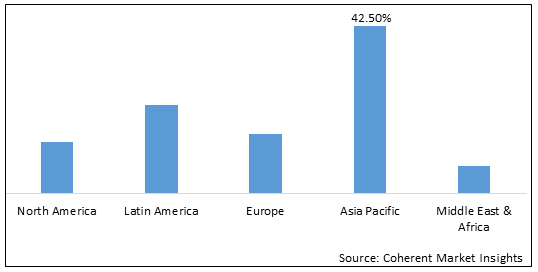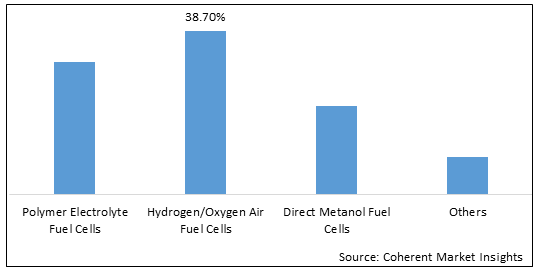The gas diffusion layers (GDL) are a fibrous porous media with two primary functions: uniform distribution of reactive gases on the electrode surfaces and electron transfer to or from the external electrical circuit. They are made of thin carbon fibers, a porous and hydrophobic material. The gas diffusion layers are a very important supporting material in a membrane electrode assembly (MEA). Gas diffusion layers are a porous substance made up of a dense array of carbon fibres that also act as an electrically conductive pathway for collecting current. GDLs are often subjected to high compression forces as part of the MEA when assembled, and thus, GDLs need to be rigid and stable enough to withstand these mechanical stresses.
Global gas diffusion layer market was valued at US$ 510.13 Million in 2021 in terms of revenue, exhibiting a CAGR of 26.09% during the forecast period (2022 to 2030).
Drivers
One of the key factors expected to stimulate market growth during the forecast period is the increasing awareness regarding harmful effects of greenhouse gases. Lack of clean energy policies has resulted in an increase in CO2 emissions across the globe. For instance, as per the article published by IEA (International Energy Agency) on March 2, 2021, the global CO2 emission rose by 2% or 60 million tons from December 2019 to December 2020. The gas diffusion layer distributes all of the gases to the membrane on which catalysts are applied which are called as catalyst coated membrane (CCM). This membrane assists in the separation of oxygen and hydrogen, thereby, transmitting positively charged protons from the anode side to the cathode side. As more gas flows homogenously across the entire cross-sectional area, more electricity is produced, which in turn increases the power density of the fuel cell.
Among regions, Asia Pacific held dominant position in the global gas diffusion layer market in 2021, accounting for 42.5% market share in terms of revenue, followed by North America and Europe. The market for gas diffusion layers has grown as a result of significant investments in fuel cell technology, especially in Japan and South Korea. Other countries such as Singapore, India, Indonesia, and Malaysia have started or are about to start exclusive fuel cell marketing programs in their respective local areas. These countries are now focusing on fuel cells for backup power (hospitals, educational institutions, and others). From 2020, India invested in fuel cell systems to supply backup power for telecommunication towers.
The COVID-19 impact across industries varies. The outbreak has impacted growth switch in every sector of the economy, and power generation sector, is no exception. The increasing spread of COVID-19 has also mandated the gas diffusion layer manufacturers to deploy precautionary measures in their facilities including labors and plant controllers screening and monitoring and sanitizing the facilities. This has further increased the plant operational costs, which has indirectly increased the prices of these high value-added carbon paper. However, unlocking and reopening of industries coupled with shifting focus on production and sustainable development is expected to boost the growth of the energy sector over the post-pandemic period. For instance, as per the article by The International Energy Agency (IEA) on March 2, 2021, the global energy demand gained momentum in December 2020, after showing a dip of around 6% in April 2020.
Figure 1. Global Gas Diffusion Layer Market Value Share (%), By Region, 2021

To learn more about this report, Request sample copy
Market Restraints
High cost associated with gas diffusion layer has negatively affected the gas diffusion layer market. The major base material in gas diffused layers is polyacrylonitrile (PAN). Since, the cost of PAN is higher (~US$ 15-20 per kg) as compared to other natural fibers such as cotton or bamboo fiber, the demand for gas infused layers is expected to get hampered to some extent. Moreover, the raw material used in the gas diffusion layer such as PAN or carbon cloth or paper should have high graphitization temperatures (~1700°C) for attaining higher conductivity and post-carbonization treatment, which further adds up to additional costs. These factors are projected to hinder the demand for gas infused layers to some extent.
Gas Diffusion Layer Market Report Coverage
| Report Coverage | Details | ||
|---|---|---|---|
| Base Year: | 2021 | Market Size in 2021: | US$ 510.13 Mn |
| Historical Data for: | 2017-2020 | Estimated Year: | 2022 |
| Forecast Period 2022 to 2030 CAGR: | 26.09% | Forecast Period: | 2022-2030 |
| Geographies covered: |
|
||
| Segments covered: |
|
||
| Companies covered: |
AvCarb Llc., Caplinq Corporation, Freudenberg Group, Fuel Cells Etc., Mitsubishi Chemical Corporation, Mott Corporation, SGL Carbon, Technical Fibre Products, Toray Industries, Inc., and GKD Gebr. Kufferath AG. |
||
| Growth Drivers: |
|
||
| Restraints & Challenges: |
|
||
Uncover macros and micros vetted on 75+ parameters: Get instant access to report
Market Trends
Adoption of several marketing strategies by the key players have seen a major growth in the market. Key players are focusing on strategies such as mergers, acquisitions, and capacity expansions to increase their geographical reach and widen their product portfolio in the global gas diffusion layer market. For instance, in March 2020, Toray Industries, Inc.'s Germany-based subsidiary, Greenerity, constructed its second factory in Bavaria, Germany. This new facility manufactures, develops, and distributes essential parts for hydrogen fuel cells and water electrolyzers.
On the basis of application, in 2021, hydrogen/oxygen air fuel cells segment held largest revenue share of 38.7% in global gas diffusion layer market. Being a carrier of energy, hydrogen fuel cells can be applied in a variety of use cases. Typical applications of fuel cell can be categorized into two major types: stationary power transportation and other applications including portable power. Governments across the globe are taking initiatives to promote hydrogen fuel cells for transportation.
Figure 2. Global Gas Diffusion Layer Market Value Share (%), By Application, 2021

To learn more about this report, Request sample copy
Recent Developments
Competitive Section
Major players operating in the global gas diffusion layer market include AvCarb Llc., Caplinq Corporation, Freudenberg Group, Fuel Cells Etc., Mitsubishi Chemical Corporation, Mott Corporation, SGL Carbon, Technical Fibre Products, Toray Industries, Inc., and GKD Gebr. Kufferath AG.
Share
Share
Missing comfort of reading report in your local language? Find your preferred language :
Transform your Strategy with Exclusive Trending Reports :
Frequently Asked Questions
Select a License Type
Credibility and Certifications

860519526

9001:2015
27001:2022


Joining thousands of companies around the world committed to making the Excellent Business Solutions.
View All Our Clients
US Reciprocal Tax Impact Analysis On Gas Diffusion Layer Market
Stay updated on tariff changes with expert insights and timely information